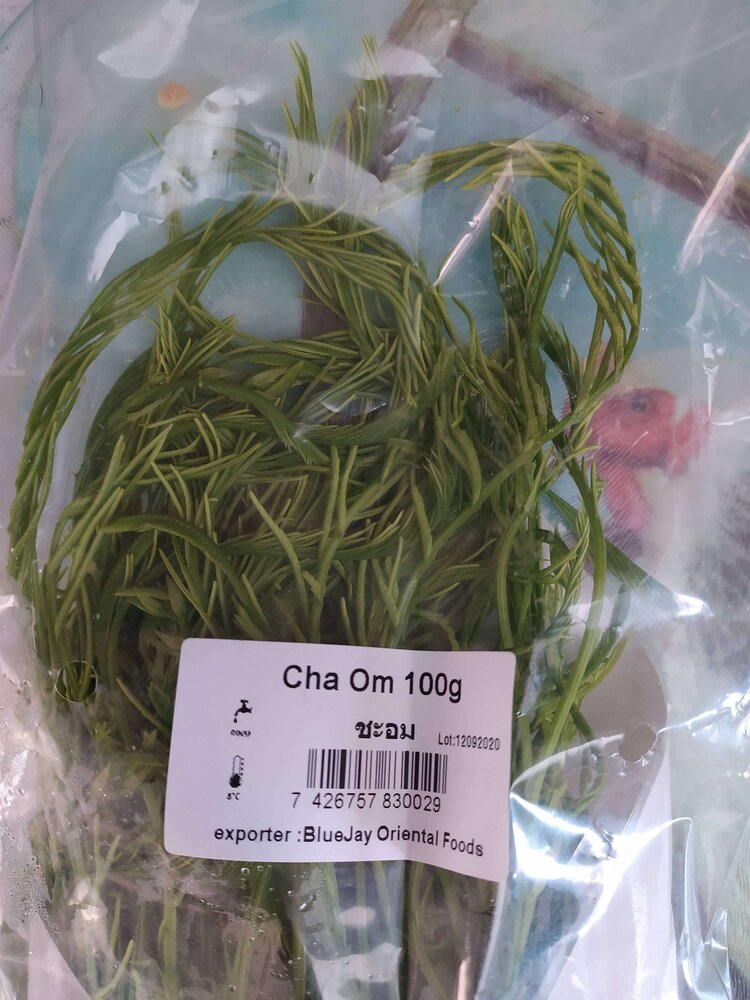A Thai Omelette with Cha Om
This is a recipe for a simple and delicious Thai omelette. But there’s a twist: the unexpected ingredient here, which is cha om. Don’t worry if you’re scratching your head; I’ll explain everything.
What is Cha Om?

Cha Om (ชะอม) is a member of the acacia genus of shrubs and trees. It grows in and is native to mainland Southeast Asia. The tender leaves of Cha Om are eaten with particular enthusiasm and universal enjoyment among the populations of Thailand, Myanmar, Cambodia and Laos.
The tropical rainy season, which generally lasts from May to October, is when this shrub flourishes. Cha Om grows rapidly at this time. However, its pungent and somewhat off-putting smell becomes even stronger during rainy season growth, so some people prefer cooking and eating dry season harvests.
The tender tips are the edible parts. As you get close to the stems, the plant becomes quite thorny. When cooking, you need to take care to use only the tender tips and discard the rest.
Nutritionally, Cha Om is high in vitamin C, and it’s always nice to have more vitamin C in your diet!
You should be able to pick up some fresh Cha Om if you have a good Asian market in your town or city. For example, here in Dublin where I live, 10,000 kilometers from Thailand, I can find Cha Om pretty easily.
Bizarrely, you can apparently order fresh Cha Om on Amazon UK, which I was pretty shocked at. If you’re in the UK and you order this, please let me know what it’s like.
Why Cha Om and Eggs?
When you first smell cha om, you could be forgiven for wondering why people even eat it. But don’t worry, the astringent, metallic smell goes away when you cook the leaves.
Cha om and eggs work well together because when you cook cha om, its flavor becomes quite pleasantly nutty, mellow, and fragrant. It kind of functions as a herb.
It’s worth noting that few people eat Cha Om on its own; they often add it to enhance other dishes in the same way as some parsley or coriander would enhance certain dishes. I have seen it deep-fried a few times but never tried it.
Thai Omelette with Cha Om
This Thai omelette is similar to a frittata in that it should be thicker than a normal omelette. The point of this thickness is that the omelette has some body to it, so that you can easily dip chunks of it into some famous Thai chili dips, such as nam prik kapi (fermented shrimp paste dip).
Personally, I don’t tend to go as thick as you’d find in Thailand with this type of omelette, but I definitely go thicker than say, a classic omelette.
It’s also worth mentioning that this recipe works perfectly well without the Cha Om. I just wanted to add a bit of excitement and maybe help you try something you’ve never had before. If you can’t get this strange shrub, leave it out and continue with the recipe.
I hope you enjoy this recipe. Make sure to check out other popular recipes, such as my morning glory stir-fry.
I also have a Thai cookbook, Thai Food At Home, which costs just $3.99…that’s less than the price of a Pad Thai at your local takeout. You can grab a copy here.

| Prep Time | 5 minutes |
| Cook Time | 4 minutes |
| Servings | people |
- 3 eggs
- 1 teaspoon Thai fish sauce Leave out if you want.
- 1 teaspoon ground black pepper
- 1 handful cha-om (tropical acacia) Find at any good Asian market. Omit if you can't find it.
- 1 teaspoon light soy sauce
- 1.5 tablespoon cooking oil
Ingredients
|  |
- Crack 3 eggs into a medium-sized bowl and beat with a fork for 30 seconds. Set aside.
- Pick the tender shoots from the cha om until you have a handful's worth.
- Add the cha om to the beaten egg. Season with fish sauce, black pepper, and soy sauce. Mix together with fork.
- Heat the oil in a small frying pan on a medium heat. It's important to use a small pan to get a thicker omelette.
- Cook for 3-4 minutes until well set. Serve alone or with steamed jasmine rice.
I lived in Thailand for a few years during my 20s during which time I fell in love with Thai food. Along with my Thai partner, I cook and eat tasty Thai dishes 3 or 4 times per week. I’m here to bring you recipes, Thai food tips, and suggested cookware for making Thai food.